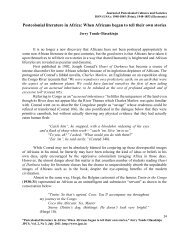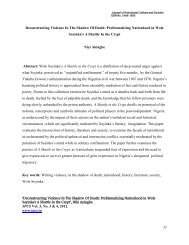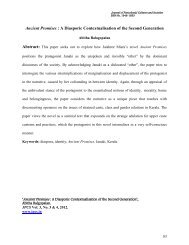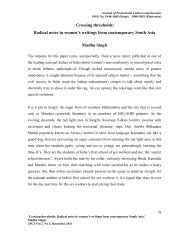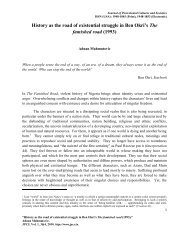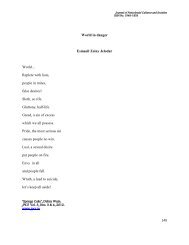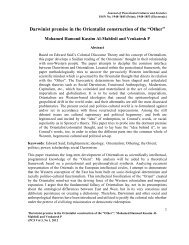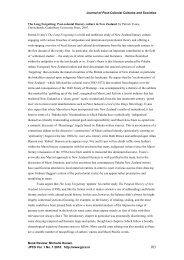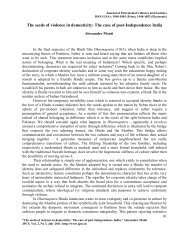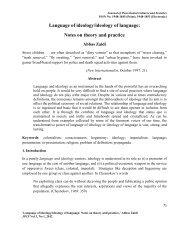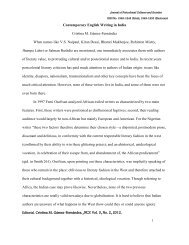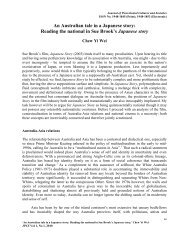'Complicity and resistance: Women in Arundhati Roy's The - JPCS
'Complicity and resistance: Women in Arundhati Roy's The - JPCS
'Complicity and resistance: Women in Arundhati Roy's The - JPCS
Create successful ePaper yourself
Turn your PDF publications into a flip-book with our unique Google optimized e-Paper software.
Journal of Postcolonial Cultures <strong>and</strong> Societies<br />
ISSN No. 1948-1845 (Pr<strong>in</strong>t); 1948-1853 (Electronic)<br />
Roy, <strong>in</strong> <strong>The</strong> God of Small Th<strong>in</strong>gs <strong>and</strong> her numerous non-fictional writ<strong>in</strong>gs as <strong>in</strong>timated <strong>in</strong><br />
the <strong>in</strong>terviews <strong>in</strong> <strong>The</strong> Shape of the Beast(2009), deals with the fate of the subalterns, both<br />
local <strong>and</strong> global, <strong>in</strong>clud<strong>in</strong>g women. Generally considered a k<strong>in</strong>d of a fem<strong>in</strong>ist, the author<br />
does not focus on the question of women severed from other subalterns. Roy‟s treatment<br />
of the issues of women <strong>in</strong> her fiction, aga<strong>in</strong>, is different from her exam<strong>in</strong>ation of the state<br />
of women <strong>in</strong> her non-fictional writ<strong>in</strong>gs. In her novel the women are represented as<br />
subalterns at par with the untouchable Velutha <strong>and</strong> the children Rahel <strong>and</strong> Estha. In her<br />
non-fictional writ<strong>in</strong>gs, Roy deals with specific issues <strong>and</strong> comments sparsely <strong>in</strong> a<br />
theoretical mode about their <strong>in</strong>terrelationship. She seldom makes comments like these:<br />
“Deep at the heart of the horror of what‟s go<strong>in</strong>g on lies the caste system: this layered,<br />
horizontally divided society with no vertical bolts, no glue, no <strong>in</strong>termarriage, no social<br />
m<strong>in</strong>gl<strong>in</strong>g; no human-humane-<strong>in</strong>teraction that holds the layers together.” (2009, p. 6) <strong>The</strong><br />
complexity of texture, allusiveness, Joycean stream of consciousness, <strong>and</strong> <strong>in</strong>tertextuality<br />
make the novel a much more articulate though ambiguous document about the subalterns<br />
<strong>in</strong> post-colonial India, <strong>in</strong>clud<strong>in</strong>g its women than many of her non-fictional writ<strong>in</strong>gs.<br />
But, be<strong>in</strong>g ambiguous, the novel does not provide or show any bluepr<strong>in</strong>t for the women<br />
to be emancipated from the three k<strong>in</strong>ds of oppression of caste, class <strong>and</strong> gender. All<br />
women are also not equally affected by these three k<strong>in</strong>ds of repressive regimes. While we<br />
do agree that there are def<strong>in</strong>ite similarities between the <strong>in</strong>sights of the Subaltern Studies<br />
Project <strong>and</strong> the views of <strong>Arundhati</strong> Roy, we have to keep <strong>in</strong> m<strong>in</strong>d that while the members<br />
of the Subaltern Studies Collective were/are theoretically <strong>in</strong>formed historians,<br />
sociologists, <strong>and</strong> people of similar academic backgrounds; Roy is primarily a writer,<br />
writ<strong>in</strong>g for an <strong>in</strong>choate readership, as well as a committed activist. Needham‟s words<br />
about Ranajit Guha <strong>in</strong> her article, (l<strong>in</strong>k<strong>in</strong>g Guha <strong>and</strong> Roy) towards the end talks of the<br />
utopian desires <strong>in</strong> Guha‟s Small Voice of History <strong>and</strong> Roy‟s <strong>The</strong> God of Small Th<strong>in</strong>gs,<br />
<strong>and</strong> comments: “Guha‟s „utopian aspiration‟, <strong>in</strong> other words , is not only to „achieve‟<br />
what Scwarz characterizes as „the impossible ideal of allow<strong>in</strong>g an unmediated subaltern<br />
voice to speak‟ through <strong>and</strong> <strong>in</strong> the „textual space‟ (O‟Hanlon‟s words) his work wishes to<br />
‘Complicity <strong>and</strong> <strong>resistance</strong>: <strong>Women</strong> <strong>in</strong> <strong>Arundhati</strong> Roy’s <strong>The</strong> God of Small Th<strong>in</strong>gs,’ Golam Gaus Al-<br />
Quaderi <strong>and</strong> Muhammad Saiful Islam<br />
<strong>JPCS</strong> Vol 2 No 4, December 2011<br />
75



